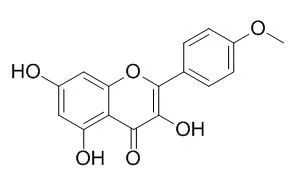| Cell Research: |
| Phytother Res. 2010 Sep;24(9):1302-8. | | Inhibition of in vitro growth and arrest in the G0/G1 phase of HCT8 line human colon cancer cells by kaempferide triglycoside from Dianthus caryophyllus.[Pubmed: 20104502] | The effects of phytoestrogens have been studied in the hypothalamic-pituitary-gonadal axis and in various non-gonadal targets. Epidemiologic and experimental evidence indicates a protective effect of phytoestrogens also in colorectal cancer. The mechanism through which estrogenic molecules control colorectal cancer tumorigenesis could possibly involve estrogen receptor beta, the predominantly expressed estrogen receptor subtype in colon mucosa.
METHODS AND RESULTS:
To validate this hypothesis, we therefore used an engineered human colon cancer cell line induced to overexpress estrogen receptor beta, beside its native cell line, expressing very low levels of ERbeta and not expressing ERalpha; as a phytoestrogenic molecule, we used Kaempferide triglycoside, a glycosylated flavonol from a Dianthus caryophyllus cultivar. The inhibitory properties of this molecule toward vegetal cell growth have been previously demonstrated: however, no data on its activity on animal cell or information about the mechanism of this activity are available. Kaempferide triglycoside proved to inhibit the proliferation of native and estrogen receptor beta overexpressing colon cancer cells through a mechanism not mediated by ligand binding dependent estrogen receptor activation. It affected HCT8 cell cycle progression by increasing the G(0)/G(1) cell fraction and in estrogen receptor beta overexpressing cells increased two antioxidant enzymes. Interestingly, the biological effects of this Kaempferide triglycoside were strengthened by the presence of high levels of estrogen receptor beta.
CONCLUSIONS:
Pleiotropic molecular effects of phytoestrogens may explain their protective activity against colorectal cancer and may represent an interesting area for future investigation with potential clinical applications. | | Rsc Adv., 2015, 5(122):100912-22. | | Kaempferide, the most active among the four flavonoids isolated and characterized from Chromolaena odorata, induces apoptosis in cervical cancer cells while being pharmacologically safe[Reference: WebLink] | Chromolaena odorata, commonly known as Siam weed, is popular as a traditional medicine. We report the isolation and characterization of four compounds from a cytotoxic fraction, F-17, isolated from the dichloromethane (DCM) extract of C. odorata by bioactivity-guided fractionation.
METHODS AND RESULTS:
The organic extracts were screened in five cancer cell lines of various origins for their cytotoxic effect. The DCM extract exhibited maximum cytotoxicity and was purified by silica gel column chromatography to obtain four major compounds. The compounds were characterized by 1H-NMR, 13C-NMR, and HR-MS methods and were found to be acacetin (1), dihydroKaempferide (2), isosakuranetin (3), and Kaempferide (4). MTT assay was used for preliminary evaluation of the cytotoxicity of these compounds. Among the cancer cell lines that were screened, HeLa was the most sensitive to Kaempferide (IC50: 16 μM) followed by acacetin (174 μM), dihydroKaempferide (>200 μM) and isosakuranetin (>200 μM). Kaempferide (4) induced morphological characteristics of apoptosis in HeLa cells and was non-toxic to rapidly dividing normal human fibroblasts up to 100μM. Annexin V staining, characteristic of early stage of apoptosis was further confirmed by FACS analysis. Induction of apoptosis was illustrated by its potential to induce the cleavage of caspases and PARP.
CONCLUSIONS:
FACS analysis demonstrated that Kaempferide (4)-induced cytotoxicity is independent of cell cycle arrest. Acute and chronic toxicity studies conducted in vivo proved that the compound is pharmacologically safe. To the best of our knowledge, this is the first study reporting the anticancer potential and pharmacological safety of Kaempferide (4). |
|






 Cell. 2018 Jan 11;172(1-2):249-261.e12. doi: 10.1016/j.cell.2017.12.019.IF=36.216(2019)
Cell. 2018 Jan 11;172(1-2):249-261.e12. doi: 10.1016/j.cell.2017.12.019.IF=36.216(2019) Cell Metab. 2020 Mar 3;31(3):534-548.e5. doi: 10.1016/j.cmet.2020.01.002.IF=22.415(2019)
Cell Metab. 2020 Mar 3;31(3):534-548.e5. doi: 10.1016/j.cmet.2020.01.002.IF=22.415(2019) Mol Cell. 2017 Nov 16;68(4):673-685.e6. doi: 10.1016/j.molcel.2017.10.022.IF=14.548(2019)
Mol Cell. 2017 Nov 16;68(4):673-685.e6. doi: 10.1016/j.molcel.2017.10.022.IF=14.548(2019)